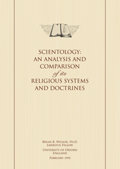X.I. Some Similarities of Scientology and Other Faiths
Scientology differs radically from traditional Christian churches and dissenting sects in matters of ideology, practice, and organization. Yet, taking the broad view which, in a multi-cultural and multi-religious society must prevail, it is evident that in all essentials, Scientology occupies a position very close to that of other movements that are indisputably religions. Ideologically, it has significant resemblances to the Sankhya school of Hinduism. In its congregational activities, which are, however, far less central to it than is the case with Nonconformist movements, there are, none the less, points of emphasis not dissimilar to those of some Nonconformist bodies. Its soteriological goals are emphatically metaphysical, and resemble in some respects those of Christian Science.
X.II. Dual Membership
A distinctive feature of Scientology is that members are not required to abandon other religious beliefs and affiliations on taking up Scientology. It might be inferred from this feature that Scientology contented itself with being a merely additional or supplementary set of beliefs and practices, but such an inference would be unwarranted. I have spoken with senior Church officials as well as individual Scientologists on this aspect of Scientology and their response was that while exclusivity is not required, it comes about as a matter of practice. According to them, as one becomes more involved with Scientology, one inevitably discards one’s prior faith. For example, my experience is that a Jew who becomes a Scientologist might remain affiliated with Judaism for cultural reasons and might celebrate Jewish holidays with family and friends, but he or she would not practise and would not believe in Jewish theology. From my view as a scholar this explanation seems correct. Scientologists regard their faith as a complete religion demanding dedication of its members.
Further, while it is a characteristic of the Judaeo-Christian-Muslim tradition that religious commitment be exclusive and that dual or multiple membership is not tolerated, this principle is far from universal among religions. It is not demanded in most branches of Hinduism and Buddhism. The Buddha did not prohibit the worship of local gods. Hinduism is tolerant in respect of plural allegiances. In Japan, large numbers of people count themselves as both Buddhists and Shintoists. The symbiosis of religions is a well-known phenomenon and in certain respects it has occurred in Christianity (for example, in the tolerance of Spiritualism or Pentecostalism by certain Anglican Bishops, even though these belief-systems were not specifically accommodated by official doctrine). The fact that Scientology adopts a different position respecting dual or multiple affiliations from that conventionally assumed in Western Christianity is not a valid ground for denying it the status of a religion.
X.III. Exoteric and Esoteric Elements of Scientology
The public image of Scientology does not conform to general stereotypes of religion. Its literature may be divided into a widely circulated exoteric literature, and an esoteric literature. The exoteric literature is concerned principally with the basic principles of Scientology metaphysics and their practical application in helping people to cope with their problems of communication, relationships, and the maintenance of intelligence, rational, and positive orientations to life. The restricted corpus of esoteric literature, which is made available only to advanced students of Scientology, presents both a fuller account of the metaphysics of the religion and more advanced techniques of auditing. It sets out in further detail the theory of the theta (primal thought of spirit); its deterioration by becoming involved in the material universe of matter, energy, space, and time in the process of past lives; and indicates the way in which man can acquire—strictly said, re-gain—supernatural abilities. Only Scientologists who are well-advanced are considered capable of grasping the import of this exposition of the belief-system and of fully comprehending the higher levels of auditing procedures set out in the esoteric literature.
In distinguishing between exoteric and esoteric teachings, Scientology is by no means unique among religions. On the principle enunciated by Jesus “I have many things to say unto you, but ye cannot bear them now” (John 16:12) and by Paul in distinguishing strong meat for seasoned believers from milk for babes (I Cor. 3:1–3; and Hebrews 5:12–14), various Christian movements have maintained a distinction between elementary and advanced doctrines and practices. The general gnostic tradition at the fringes of Christianity was explicitly committed to the preservation of esoteric doctrines, and contemporary movements sometimes categorized by scholars as “gnostic-type” sects commonly make such distinctions. An example is Christian Science, the general teachings of which are augmented by subjects taught to those aspiring to become recognized practitioners by designated teachers in special classes, the content of which is confidential. Apart from these cases, The Church of Jesus Christ of Latter-day Saints admits to its special ceremonies only those Mormons who are in good standing and receive a permit from their bishop: that indicates, inter alia, that they have been fulfilling their commitment to tithe 10 percent of their earnings to the church: no others are allowed to see these rituals. Close to the Protestant mainstream, Pentecostalists often disclose the full significance of their teaching and practice of “the gifts of the Spirit” only at designated services and not at those meetings designed to attract the non-Pentecostal public. The justification for such differentiation is also an educational principle—advanced material is available only to those who have undergone earlier and more elementary instruction which enables them to assimilate higher levels of instruction. This is the position taken by Scientology, the teachings of which require concentrated and systematized endeavour from students.





























